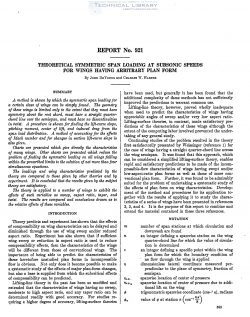naca-report-921

- Version
- 380 Downloads
- 3.63 MB File Size
- 1 File Count
- August 31, 2016 Create Date
- August 31, 2016 Last Updated
National Advisory Committee for Aeronautics, Report - Theoretical Symmetric Span Loading at Subsonic Speeds for Wings Having Arbitrary Plan Form

A method is shown by which the symmetric span loading for
a certain class of wings can be simply found. The geometry
of these wings is limited only to the eatent that they must hare
symmetry about the root chord, must have a straight quarter-
chord line over the semispan, and must have no discontinuities
in twist. A procedure is shown for finding the lift-curve slope,
pitching moment, center of lift, and induced drag from the
span load distribution. A method of aocountingfor the ejects
of ll-Iach number and for changes in section lift-curve slope is
also given.
Charts are presented which giro directly the characteristics
of many wings. Other charts are presented which reduce the
problem of finding the symmetric loading on all wings falling
within the prescribed limits to the solution of not more than four
simultaneous equations.
The loadings and wing characteristics predicted by the
theory are compared to those given by other theories and by
erperime-nt. It is concluded that the results given by the subject
theory are satisfactory.
The theory is applied to a number of wings to exhibit the
ejects of such rariables as sweep, aspect ratio, taper, and
twist. The results are compared and conclusions drawn as to
the relatiz‘e ejects of these variables.
Theory predicts and experiment has shown that the effects
of compressibility on wing characteristics can be delayed and
diminished through the use of wing sweep and/or reduced
aspect. ratio. Experiment has also shown that- if sufficient
wing sweep or reduction in aspect. ratio is used to reduce
compressibility effects, then the characteristics of the wings
will be different from those of conventional wings. The
importance of being able to predict the characteristics of
these heretofore unstudied plan forms in incompressible
flow is obvious. Not only does it become possible to make
a systematic study of the effects of major plan-form changes,
but. also a base is supplied from which the subcritical efiects
of compressibility can be predicted.
| File | Action |
|---|---|
| naca-report-921 Theoretical Symmetric Span Loading at Subsonic Speeds for Wings Having Arbitrary Plan Form.pdf | Download |

Comment On This Post